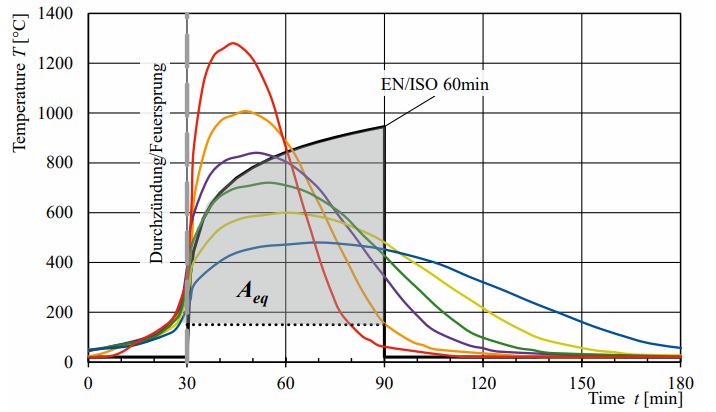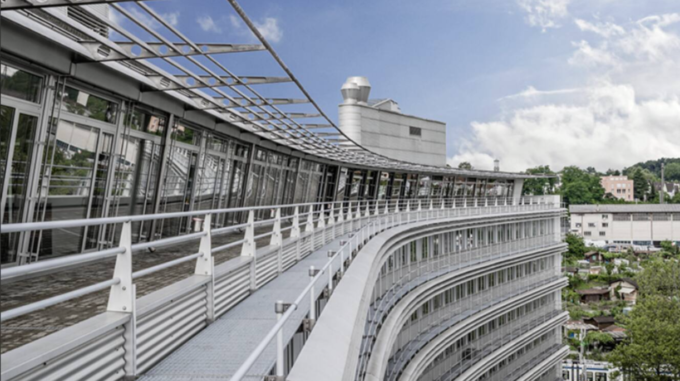Performance-oriented methods in fire protection
The history of the fire protection framework with requirements (protection objectives) and verification methods is a good 100 years old. The uniform temperature-time curve (ETK) forms the cornerstone for today's concept of fire resistance classes, but application limits must be observed.

From the early days of the ETK, wood components were included in fire resistance studies, although the first component classifications (Ministry of Works 1948) differed in terms of criteria of combustibility of the material. The further developed elements of fire protection distinguish between the fire behavior of building products (flammability is divided into different classes) and the fire resistance of building components (functional integrity of the load-bearing resistance R, the space closure E and the insulation effect I), which is tested and verified independently of the fire behavior class.
In the course of many research projects and fire resistance tests, it has been shown that the requirements (R-E-I) can be achieved by considering the fire on the wooden components. Results from fire resistance tests were used for the development of calculation methods, which can be found in Eurocode 5 (CEN 2004) and in manuals (e.g. Östman et al. 2010) and also form the basis for Swiss state of the art papers (Lignum 2014). The great advantage of general calculation methods is the flexibility gained to use a variety of designs for verification without the need for test results.
International criticism
After the successful implementation of cross-laminated timber (CLT) on the market, unimagined possibilities were opened up for timber construction.
In this respect, CLT exhibits architecturally appreciated surfaces, is dimensionally stable, can be precisely prefabricated, is relatively light, enables the transfer of large vertical and horizontal loads and a fast, dry construction method. With appropriate thick elements, high fire resistance durations can also be achieved.
On the one hand, critics recognized the surface bonding as a weak point and saw the concept of kiln testing as being deceived, since the added fuel energy (oil or gas) is only about 50 percent of the amount that would be necessary for concrete components (Schmid et al. 2018). Visible wood components thus represent an additional structural fire load, both in the test kiln and in fires. The related criticism of altered fire dynamics in fires due to exposed wood surfaces was only addressed by isolated compartment and façade fire tests until about 2010. The typically higher intensity of flames on the facade of ventilation-controlled fires was usually addressed qualitatively (e.g., Östman et al. 2010, 2018). The core of the criticism concerns the correct handling of the difficult-to-quantify structural fire load due to fire exposure of the wood components, which, depending on the design of the fire room or the supporting structure, can theoretically reach a multiple of the mobile fire load and thus strongly influence the fire event.
Background
In order to work out answers to the criticism formulated above, it is useful to discuss the background of the fire resistance concept R-E-I, e.g. a fire resistance R60 (60 minutes load-bearing capacity under ETK). Fig. 1 shows the basic idea behind the R-E-I concept.

The combustion of a defined fire load can cause either long fires with comparatively low temperatures (e.g. blue curve in Fig. 1) or short, very violent fires (e.g. red curve in Fig. 1). For the amount of energy the components are exposed to, the cumulative temperature-time curve is used as a proxy (gray area in Fig. 1), it is the same for all curves in Fig. 1. Thus, in each case, for the defined amount of fire load (here: living spaces), it can be assumed that no danger would arise from a possible structural failure for persons in adjacent occupancy units, for firefighters fighting the fire, or for adjacent parts of the building. In other words, it is expected that structures can survive a fire until burnout of the fire load. This basic idea represented an implicit protection goal defined in the development of the R-E-I fire resistance concept. It serves both personal protection (users, firefighters) and property protection (buildings or parts of buildings, adjacent units). Other requirements in building codes, e.g. R90, were introduced intuitively for other fire loads or also based on the type and use of the buildings. In some European building codes, the time of structural resistance to be demonstrated is actually determined by the total fire load quantity (Finland, Estonia). While the fire load of claddings made of wood can be quantified quite well and, according to Eurocode 1 (CEN 2021), must be considered separately in the future in addition to the mobile fire load, the procedure for structural components made of wood is not clearly defined.
Research answers
Quite quickly, the wood industry, together with the research community, was able to find first answers to counteract the falling of charred CLT layers in case of fire. To describe the reduced load-bearing resistance due to increased burning, the staircase model was presented for CLT as a direct application of the Eurocode (e.g. Frangi et al. 2009). In recent years, experience has been gained on the behavior of adhesive systems and product standards have also been created that include the requirements for CLT (ANSI/APA 2017). In addition, the description of this product property depending on the adhesive by means of tests in the firing kiln is provided for in Eurocode 5 (CEN 2021b).
The validity of furnace tests for combustible building materials can be demonstrated by matching typical test conditions with the ventilation-controlled fires to be simulated (Schmid et al. 2018). In both cases, low oxygen concentrations result in the fire compartments; thus, any additional fire load added does not result in further energy release (combustion) in the fire compartment. However, based on kiln tests, no statement can be made about the duration of fire or a burnout in a fire room independent of the combustibility of the building material. The applicability limits of the fire resistance concept discussed above are given by the implicitly set protection targets with the amount of total fire load, the effects of exceeding them should be investigated in detail.
The total energy content of structural components can be easily determined by considering the calorific value and mass. For individual linear components (e.g. a column), the contribution to the total fire load can be vanishingly small. It should be noted, however, that complete combustion of a component implies collapse of the structure. A performance-based approach can use a burnout analysis to determine whether burnout can be expected to occur before structural failure or whether the design of the fire compartment needs to be adjusted. Initial verification methods have recently been presented for this purpose (CEN 2021b, Wade et al. 2018, Brandon 2018, Schmid et al. 2021). This provides the fire protection engineer with a method to verify the protection of persons and property in accordance with the protection objectives of the fire resistance concept R-E-I in timber construction and to support the deployment of fire departments in a simple way.
In performance-oriented methods, project-specific scenarios for design fires are examined. All relevant elements of the fire protection concept (structural, technical, organizational) are included in a potential hazard. The sequence of events can be represented with decision trees (event-trees) or with the so-called Swiss-Cheese model (Fig. 2), where damage only occurs if there is permeability through all elements (cheese slices).

The more reliable an element, the fewer holes the slice has. The burnout analysis now represents an additional element (red pane in Fig. 2). With its application, the implicit protection goal of the fire resistance concept can be checked and this can be verified. This becomes important when dealing with higher buildings (Frangi et al. 2008) or with buildings or uses where no empirical values of fires (statistical data) are available.
Further reading
- ANSI/APA PRG 320 Standard for Performance-Rated Cross-Laminated Timber, 2017.
- Brandon, D. Engineering methods for structural fire design of wood buildings: structural integrity during a full natural fire. Brandforsk, 2018.
- Frangi, A. et al. Fire Design Concepts for Tall Timber Buildings, Structural Engineering International, 2008.
Frangi, A. et al. Experimental analysis of cross-laminated timber panels in fire. Fire Safety Journal. 2009 November 1; 44(8):1078-87. - CEN 2004. EN 1995-1-2: Eurocode 5: Design of Timber Structures Part 1-2: General - Structural Fire Design. European Standard, Brussels.
- CEN 2021a. prEN 1991-1-2: Eurocode 1: Actions on structures. Part 1-2: General actions - Actions on structures exposed to fire, September 2021.
- CEN 2021b. prEN 1995-1-2: Eurocode 5 (draft for revision): Design of Timber Structures Part 1-2: General - Structural Fire Design. European Standard, Brussels.
- Lignum. Technical documentation on fire protection in timber construction (10 parts), Lignum, Zurich, 2015.
- Schmid, J. et al. Fire effects on wooden components in the test kiln and in real fires. Bautechnik. 2018 Aug; 95(8):524-34.
- Schmid, J. et al. Structural timber in compartment fires - the timber charring and heat storage model. Open Engineering. 2021 Jan 1; 11(1):435-52.
- Östman, B. (ed). Fire safety in timber buildings. Technical guideline for Europe. SP, 2010:19.
- Östman, B. (ed). Guidance on Fire Safety of Bio-Based Facades, COST Action FP1404, Zurich, Switzerland, 2018. DOI: 10.3929/ethz-b-000319579.
- Wade, C. et al. Predicting the fire dynamics of exposed timber surfaces in compartments using a two-zone model. Fire technology, 54(4):893-920, 2018.
This technical article appeared in the printed issue SicherheitsForum 2-2022.
You want to read the articles of this issue? Then close right now here a subscription.









